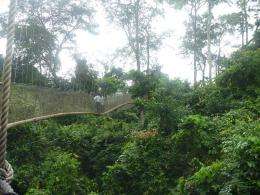August 27, 2012 report
Study finds increased biomass in West Africa despite forty year drought

(Phys.org)—Researchers from Ghana and the UK have found that contrary to what might be expected, biomass in West Africa has been increasing during the ongoing forty year drought, leading the trees there to harbor more carbon than has been theorized. The team has been looking at more than 10,000 trees in the area and have found, as they describe in their paper in Ecology Letters, that rather than succumbing to the drought, the area has prospered as the encroachment of more tolerant species has been taking over.
Traditional thinking is that when drought strikes, plants slowly begin to die, not only releasing the carbon they've stored up, but stopping the process of taking more out of the air and using it as part of the photosynthesis process. And that does appear to be the case for reasonably short term droughts. Long term droughts however, such as is happening in West Africa, might be a different story. There the team has found that trees with a higher light and lower water demand have been taking over from wet evergreen, sub-canopy, shade tolerant species, leading to an overall increase in biomass, which of course means an increase in the amount of carbon sequestered; and that gives ecologists pause, because current campaigns have been targeted at reducing human practices that can lead to droughts and the subsequent loss of carbon sequestering leading to an increase in global warming.
The conditions found in West Africa may be unique of course, and other droughts in other areas may very well lead to regions with less biomass, and less carbon sequestering; researchers just don't know. What they do know, after studying trees in the area for the period between 1990 to 2010, is that despite a twenty three percent reduction in rainfall since the 1970's, the amount of biomass has actually increased, mainly due to different types of plants moving in as those that couldn't survive on less water, died out.
The team says their research indicates that applying short term drought findings to long term droughts doesn't work and therefore ecologists will have to begin creating models specifically for long term droughts to find out if what has been happening in West Africa occurs in other places as well. They also suggest that because West Africa has experienced extreme climate changes over the past 4,000 that it built up a sort of immunity to extremes of wet and dry periods.
More information: Fauset, S., Baker, T. R., Lewis, S. L., Feldpausch, T. R., Affum-Baffoe, K., Foli, E. G., Hamer, K. C., Swaine, M. D. (2012), Drought-induced shifts in the floristic and functional composition of tropical forests in Ghana. Ecology Letters. doi: 10.1111/j.1461-0248.2012.01834.x
Abstract
The future of tropical forests under global environmental change is uncertain, with biodiversity and carbon stocks at risk if precipitation regimes alter. Here, we assess changes in plant functional composition and biomass in 19 plots from a variety of forest types during two decades of long-term drought in Ghana. We find a consistent increase in dry forest, deciduous, canopy species with intermediate light demand and a concomitant decrease in wet forest, evergreen, sub-canopy and shade-tolerant species. These changes in composition are accompanied by an increase in above-ground biomass. Our results indicate that by altering composition in favour of drought-tolerant species, the biomass stocks of these forests may be more resilient to longer term drought than short-term studies of severe individual droughts suggest.
via BBC
Journal information: Ecology Letters
© 2012 Phys.org


















